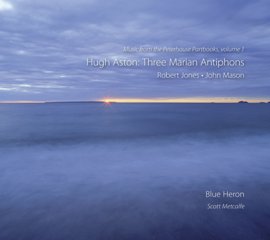Hugh Aston - Three Marian Antiphons (2010)
Hugh Aston - Three Marian Antiphons (2010)

1.Hugh Aston: Ave Maria divae matris 2.Robert Jones: Magnificat 3.Hugh Aston: Gaude virgo mater Christi 4.John Mason: Quales sumus 5.Hugh Aston: Ave Maria ancilla Blue Heron Scott Metcalfe – conductor
Blue Heron’s second CD presents superb music by three English composers of the early 16th century: Hugh Aston, Robert Jones, and John Mason. Although their music is gorgeous and of superlative quality, Aston, Jones, and Mason are virtually unknown to performers and scholars today, for the primary extant source of the music—in the case of Robert Jones’s, the sole extant source—is now incomplete through the loss of one partbook and a portion of another, out of an original set of five. The set, known as the Peterhouse partbooks for its present location in the library of Peterhouse College, Cambridge, was copied in 1540 for Canterbury Cathedral and is the largest and most important source of English music surviving from the period just before the Reformation; it contains over seventy works, fifty of which are unique to Peterhouse. Blue Heron’s recording uses brilliantly idiomatic reconstructions by Nick Sandon, a British musicologist now living in France, who has devoted his career to the music of the Peterhouse partbooks.
This is the first disc in a projected series of recordings of music from the Peterhouse partbooks and includes world premiere recordings of three works and the first of another in the form recorded here. --- Nick Sandon, blueheron.org
Among recent CDs in the polyphonic field, a recording by the Boston ensemble Blue Heron stands out, and not only because of the group’s pleasingly quirky name. The director of Blue Heron is Scott Metcalfe… His aim is to bring expressive intensity, even a hint of Baroque flair, to the earlier repertory…
The new Blue Heron disk…gathers five-part religious pieces by English composers of the early Tudor period: Robert Jones, John Mason, and, most significant, Hugh Aston… Only ten pieces by Aston survive, but they reveal a composer with a knack for generating brilliant climaxes from simple material. …
Of course, my sense of Aston’s voice owes much to Blue Heron’s imaginative realization of his scores. Through an array of interpretive choices—fine gradations of dynamics; pungent diction; telling contrasts of ethereal and earthly timbres; tempos that are more lusty than languid; a way of propelling a phrase toward a goal—the music takes on narrative momentum, its moods dovetailing with the theme of the text. Listen to the brazen, almost raucous tone of the sopranos as they arrive, in “Ave Maria dive matris Anne,” at the self-reflexive phrase “psallentes et omnes hoc Ave Maria”—”and all singing this Hail Mary.” Or to the joyous thrust of the basses in the Amen coda of Aston’s “Gaude virgo mater Christi,” as they repeat a phrase in which one interval keeps widening, from a third to a fourth and, finally, to a fifth. …
The seemingly serene music of Renaissance church ritual did not stem from yoga-like spells of meditation. Instead, as Andrew Kirkwood observes, it communicated a desperate plea for mercy—in particular, “the desire to shorten the time in purgatory that, short of sainthood and immediate passage to paradise, would follow earthly life.” … It is good to feel a hint of turbulence, of mortal fear, in performances such as Blue Heron’s…; with that quiver of passion, the music inspires even greater awe. --- Alex Ross, The New Yorker 2011
download (mp3 @320 kbs):
yandex 4shared mega mediafire zalivalka cloudmailru uplea ge.tt
Zmieniony (Wtorek, 08 Listopad 2016 15:07)
